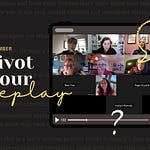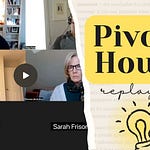Not everyone who wants to create is trying to be a brand.
Not everyone publishing on Substack wants to niche, polish or optimize.
Some of us are trying to reclaim creativity as a way of thinking, feeling and belonging. That’s what this Publishing Lab was about — and here are the key insights
and I explored, for those of you who want the takeaways without watching the full replay.1. You Don’t Need a Niche — You Need Continuity of Spirit
If you’ve been told you need to define a niche or narrow your focus to grow your audience, you’re not alone — but you might be getting advice meant for a different kind of work.
“That kind of advice comes from LinkedIn culture — not from artists. You're not a brand. You're a person.” — Jane
What actually builds trust online isn’t sameness. It’s coherence. And coherence can come from your spirit, not just a straight jacket strategy.
“If you're sharing from a true place, your audience can feel it. Even when the form changes.” — Amanda
Instead of asking, Is this on brand?, try asking: Is this connected to my curiosity? Does it come from the same internal place?
2. Art Doesn’t Have to Be Hard to Be Valuable
Many of us carry a quiet belief that creative work only “counts” if it feels effortful, complex, or painful.
Jane shared a moment from her own process — when a project came together with surprising ease, and her immediate thought was: Can it still be good if it didn’t cost me something?
That internalized belief — that struggle equals legitimacy — runs deep. But we don’t have to let it drive the work.
3. Visual Work Isn’t Decoration — It’s Emotional Infrastructure
Most people underestimate the emotional impact of visuals — especially on a writing-first platform like Substack. But as the digital landscape gets more saturated, visuals aren’t just nice to have — they’re what help people feel what you’re saying.
Visual language also helps you communicate before you’re ready to name something. It can hold ambiguity, softness, and emotion that text alone sometimes can’t.
Start by identifying the emotional quality of your post — is it sharp or soft? Quiet or bold? Feminine or grounded? Let your image echo that energy. — Jane
You don’t need to be a designer or illustrator. You just need to pay attention to feeling — and let it guide your choices.
4. Trying New Mediums Rewires Your Brain — Literally
Engaging in a new creative mode — like drawing instead of writing — isn’t a detour. It’s neural cross-training.
You’re strengthening cross-lateral pathways in the brain. That doesn’t just help the new skill — it improves your capacity in the areas you already work in. — Jane
Trying something unfamiliar builds new connections in your brain that expand your creative capacity overall. It’s not distraction — it’s deepening.
💬 What Attendees Had To Say
“I want to thank everyone for an enlightening hour. I’ll be taking so many of your thoughts with me. I love that I now have permission to incorporate the visual in my expressions.” —
(in chat)“I love the idea of inviting readers to skip down the garden path with you, even when you’re experimenting with something and aren’t exactly sure if or how it fits.” —
(in chat)“Mine is the same as Jamie’s — to give readers credit that they’ll follow some of my own experimentation and find it interesting.” —
(in chat)“I’m imagining starting from where I’m blocked.” —
(in chat)“I’m taking away Jane’s gem about the niching advice coming from corporate energy — and I’m not a corporation.” — Nova (in chat)
Subscribe for More
This summer, we're continuing a series of conversations and Publishing Labs for artists, writers and creatively curious people who want to build work on Substack that’s more alive — and less algorithmic.
Subscribe to get:
New essays on art and publishing
Invitations to upcoming labs
Access to a growing archive of practical, expansive conversations
☀️ Coming in July: Publishing Lab with Jane Pike
In our next session, we’ll move from reflection to practice.
We’ll explore:
How to use images and formatting to shape reader emotion
Visual language as a tool for connection — not just branding
Gentle ways to explore aesthetic cohesion (even if you’re not “visual”)
It’s not about having the perfect look — it’s about telling the truth in every layer of your work.
We’d love to have you with us.













Share this post